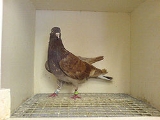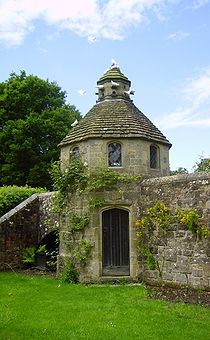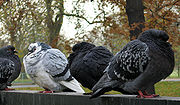
Domestic Pigeon
Encyclopedia

Rock Pigeon
The Rock Dove or Rock Pigeon, is a member of the bird family Columbidae . In common usage, this bird is often simply referred to as the "pigeon"....
. The Rock Pigeon is the world's oldest domesticated bird. Mesopotamia
Mesopotamia
Mesopotamia is a toponym for the area of the Tigris–Euphrates river system, largely corresponding to modern-day Iraq, northeastern Syria, southeastern Turkey and southwestern Iran.Widely considered to be the cradle of civilization, Bronze Age Mesopotamia included Sumer and the...
n cuneiform
Cuneiform script
Cuneiform script )) is one of the earliest known forms of written expression. Emerging in Sumer around the 30th century BC, with predecessors reaching into the late 4th millennium , cuneiform writing began as a system of pictographs...
tablets mention the domestication of pigeons more than 5,000 years ago, as do Egypt
Egypt
Egypt , officially the Arab Republic of Egypt, Arabic: , is a country mainly in North Africa, with the Sinai Peninsula forming a land bridge in Southwest Asia. Egypt is thus a transcontinental country, and a major power in Africa, the Mediterranean Basin, the Middle East and the Muslim world...
ian hieroglyphics.
Research suggests that domestication of pigeons was as early as ten thousand years ago. People who keep domestic pigeons are generally called pigeon fanciers
Pigeon keeping
Pigeon keeping is the art and science of breeding domestic pigeons. People have practiced pigeon keeping for about 10,000 years in almost every part of the world...
. Domestic pigeons can often be distinguished from feral pigeons
Feral Pigeon
Feral pigeons , also called city doves, flying rats, city pigeons or street pigeons, are derived from domestic pigeons that have returned to the wild. The domestic pigeon was originally bred from the wild Rock Pigeon, which naturally inhabits sea-cliffs and mountains. All three types readily...
because they usually have a metal or plastic band around one (sometimes both) legs which shows, by a number on it, that they are registered to an owner.
Pigeons have made contributions of considerable importance to humanity, especially in times of war. In war the homing ability of pigeons has been put to use by making them messengers. So-called war pigeon
War pigeon
Pigeons have long played an important role in war. Due to their homing ability, speed, and altitude, they were often used as military messengers. After World War II, they ceased being used.- Nineteenth century :...
s have carried many vital messages and some have been decorated for their services. Medals such as the Croix de guerre
Croix de guerre
The Croix de guerre is a military decoration of France. It was first created in 1915 and consists of a square-cross medal on two crossed swords, hanging from a ribbon with various degree pins. The decoration was awarded during World War I, again in World War II, and in other conflicts...
, awarded to Cher Ami
Cher Ami
Cher Ami was a registered Black Check Cock homing pigeon which had been donated by the pigeon fanciers of Britain for use by the U.S. Army Signal Corps in France during World War I and had been trained by American pigeoneers...
, and the Dickin Medal
Dickin Medal
The Dickin Medal was instituted in 1943 in the United Kingdom by Maria Dickin to honour the work of animals in war. It is a bronze medallion, bearing the words "For Gallantry" and "We Also Serve" within a laurel wreath, carried on a ribbon of striped green, dark brown and pale blue...
awarded to the pigeons G.I. Joe
G.I. Joe (pigeon)
G.I. Joe was a pigeon noted for his service in the United States Army Pigeon Service.During World War II, G.I. Joe saved the lives of the inhabitants of the village of Calvi Vecchia, Italy, and of the British troops occupying it...
and Paddy
Paddy (pigeon)
Paddy was an Irish carrier pigeon awarded the Dickin Medal after being the fastest pigeon to arrive back in England with news of the success of the D-Day invasion, out of hundreds dispatched...
, amongst 32 others, have been awarded to pigeons for their services in saving human lives. Despite this, many people consider pigeons to be pests. Domestic pigeons are sometimes called "thoroughbreds of the air," while feral pigeons are sometimes called "rats with wings."
Reproduction
Domestic pigeons reproduce in a similar way to the wild Rock Pigeon. Generally humans will select breeding partners. Crop milkCrop milk
Crop milk is a secretion from the lining of the crop of parent birds that is regurgitated to young birds. They are found among all pigeons and doves where they are referred to as pigeon milk...
produced by parent birds may occasionally be replaced with artificial substitutes. Baby pigeons are called squeakers.
See Also:-Gallery
Homing pigeons

1 E6 m
To help compare different orders of magnitude this page lists lengths starting at 106 m .Distances shorter than 106 metres-Conversions:1 megametre is equal to:* 1 E+6 m * approximately 621.37 miles...
away. A special breed, called homing pigeon
Homing pigeon
The homing pigeon is a variety of domestic pigeon derived from the Rock Pigeon selectively bred to find its way home over extremely long distances. The wild rock pigeon has an innate homing ability, meaning that it will generally return to its own nest and its own mate...
s has been developed through selective breeding to carry messages and members of this variety of pigeon are still being used in the sport of pigeon racing
Pigeon racing
Pigeon racing is the sport of releasing specially trained racing pigeons, which then return to their homes over a carefully measured distance...
and the white release dove
Release Dove
A release dove refers to any breed of domestic pigeon used for ceremonial release. Release doves are often used to commemorate important milestones of life and offerings of hope at weddings and birthdays and as representing the soul's final journey at funerals...
ceremony at weddings and funerals.
The ability a pigeon has to return home from a strange location necessitates two sorts of information. The first, called "map sense" is their geographic location. The second, "compass sense" is the bearing they need to fly from their new location in order to reach their home. Both of these senses, however, respond to a number of different cues in different situations. The most popular conception of how pigeons are able to do this is that they are able to sense the Earth's magnetic field
Earth's magnetic field
Earth's magnetic field is the magnetic field that extends from the Earth's inner core to where it meets the solar wind, a stream of energetic particles emanating from the Sun...
with tiny magnetic tissues in their head (magnetoception
Magnetoception
Magnetoception is the ability to detect a magnetic field to perceive direction, altitude or location. This sense plays a role in the navigational abilities of several animal species and has been postulated as a method for animals to develop regional maps.Magnetoception is most commonly observed in...
). This is all the more surprising as they are not a migratory
Bird migration
Bird migration is the regular seasonal journey undertaken by many species of birds. Bird movements include those made in response to changes in food availability, habitat or weather. Sometimes, journeys are not termed "true migration" because they are irregular or in only one direction...
species, which is a fact used by some ornithologists to dispute this theory. Another theory is that pigeons have compass sense, which uses the position of the sun, along with an internal clock, to work out direction. However, studies have shown that if magnetic disruption or clock changes disrupt these senses, the pigeon can still manage to get home. The variability in the effects of manipulations to these sense of the pigeons indicates that there is more than one cue on which navigation is based and that map sense appears to rely on a comparison of available cues
Other potential cues used include:
- The use of a sun compass
- Nocturnal navigate by stars
- Visual landmark map
- Navigation by infrasound map
- Polarised light compass
- Olfactory stimuli
-
- see: Olfactory navigationOlfactory navigationOlfactory navigation is a hypothesis put forward to explain navigation and homing of pigeons, in particular the homing pigeon.There are two principal versions. Papi’s mosaic model proposes that pigeons construct a map from the distribution of environmental odours, within a radius of 70-100 kilometres...
- see: Olfactory navigation
For food
Pigeons are also bred for meat, generally called squab and harvested from young birds. Pigeons grow to a very large size in the nest before they are fledgeFledge
Fledge is the stage in a young bird's life when the feathers and wing muscles are sufficiently developed for flight. It also describes the act of a chick's parents raising it to a fully grown state...
d and able to fly, and in this stage of their development (when they are called squabs) they are prized as food. For commercial meat production a breed of large white pigeon, named "King pigeon
King (pigeon)
The King is a breed of pigeon developed over many years of selective breeding primarily as a utility breed. Kings along with other varieties of domesticated pigeons are all descendants from the Rock Pigeon ....
," has been developed by selective breeding. Breeds of Pigeons developed for their meat are collectively known as Utility Pigeons
Utility pigeon
Utility pigeons are domesticated pigeons bred for a source of meat called squab. Squabs have been used as a food by many nations for centuries. They were selected as birds that would breed and grow quickly...
.
Exhibition breeds
Pigeon fanciersPigeon keeping
Pigeon keeping is the art and science of breeding domestic pigeons. People have practiced pigeon keeping for about 10,000 years in almost every part of the world...
developed many exotic forms of pigeon. These are generally classed as fancy pigeons. The Fanciers compete against each other at exhibitions or shows and the different forms or breeds are judged to a standard
Breed standard
A breed standard in animal fancy and animal husbandry is a set of guidelines which is used to ensure that the animals produced by a breeder or breeding facility conform to the specifics of the breed....
to decide who has the best bird. Among those breeds are the English Carrier
English Carrier
The English Carrier is a breed of fancy pigeon developed over many years of selective breeding. English Carriers, along with other varieties of domesticated pigeons, are all descendants of the Rock Pigeon...
s, a variety of pigeon with wattles
Wattle (anatomy)
A wattle is a fleshy dewlap or caruncle hanging from various parts of the head or neck in several groups of birds, goats and other animals. In some birds the caruncle is erectile tissue.The wattle is frequently an organ of sexual dimorphism...
and a unique, almost vertical, stance (pictures). There are many ornamental breeds of pigeons, including the "Duchess" breed, which has as a prominent characteristic feet that are completely covered by a sort of fan of feathers. The Fantails
Fantail (pigeon)
The Fantail is a popular breed of fancy pigeon. It is characterised by a fan-shaped tail composed of 30 to 40 feathers, abnormally more than most members of the pigeon family, which usually have 12 to 14 feathers. The breed is thought to have originated in India, China or Spain. There are several...
are also very ornamental with their fan-shaped tail feathers.
Flying/Sporting
Pigeons are also kept by enthusiasts for the enjoyment of Flying/SportingFlying/Sporting Pigeons
Flying/Sporting is the name of one of three main groupings of breeds of domesticated pigeons used by pigeon fanciers in the United States. The other two are Fancy and Utility....
competitions. Breeds such as Tippler
Tippler
A Tippler is a breed of domestic pigeon bred to participate in endurance competitions. Flying results of up to 22 hours have been reported .-Origin:...
s are flown in endurance contests by their owners.
Experimentation
Domestic pigeons are also commonly used in laboratory experiments in biology, medicine and cognitive scienceCognitive science
Cognitive science is the interdisciplinary scientific study of mind and its processes. It examines what cognition is, what it does and how it works. It includes research on how information is processed , represented, and transformed in behaviour, nervous system or machine...
.
Cognitive science
Pigeons have been trained to distinguish between cubistCubism
Cubism was a 20th century avant-garde art movement, pioneered by Pablo Picasso and Georges Braque, that revolutionized European painting and sculpture, and inspired related movements in music, literature and architecture...
and impressionist
Impressionism
Impressionism was a 19th-century art movement that originated with a group of Paris-based artists whose independent exhibitions brought them to prominence during the 1870s and 1880s...
paintings, for instance. In Project Sea Hunt, a US coast guard search and rescue project in the 1970s/1980s, pigeons were shown to be more effective than humans in spotting shipwreck victims at sea. Research in pigeons is widespread, encompassing shape and texture perception, exemplar and prototype memory, category-based and associative concepts, and many more unlisted here (see Pigeon intelligence
Pigeon intelligence
Pigeons have featured in numerous experiments in comparative psychology, including experiments concerned with animal cognition, and as a result we have considerable knowledge of pigeon intelligence.Available data show, for example, that:...
and discrimination abilities of pigeons).
Illegal predator killing by enthusiasts
In the US, some pigeon keepers illegally trap and kill hawkHawk
The term hawk can be used in several ways:* In strict usage in Australia and Africa, to mean any of the species in the subfamily Accipitrinae, which comprises the genera Accipiter, Micronisus, Melierax, Urotriorchis and Megatriorchis. The large and widespread Accipiter genus includes goshawks,...
s and falcon
Falcon
A falcon is any species of raptor in the genus Falco. The genus contains 37 species, widely distributed throughout Europe, Asia, and North America....
s to protect their pigeons. In American pigeon-related organizations, enthusiasts openly shared their experiences of killing hawks and falcons, although this is frowned upon by the majority of fanciers. None of the major clubs condone this practice. It is estimated that almost 1000 birds of prey have been killed in Oregon and Washington, and that 1 to 2 thousand are killed in southern California annually. In June 2007, three Oregon men were indicted with misdemeanour violations of the Migratory Bird Treaty Act for killing birds of prey. Seven Californians and a Texan have also been charged in the case.
In the West Midlands region of the United Kingdom
United Kingdom
The United Kingdom of Great Britain and Northern IrelandIn the United Kingdom and Dependencies, other languages have been officially recognised as legitimate autochthonous languages under the European Charter for Regional or Minority Languages...
pigeon fanciers have been blamed for a trap campaign to kill peregrine falcons. Eight illegal spring-loaded traps were found close to peregrine nests and at least one of the protected birds died. The steel traps are thought to have been set as part of a “concerted campaign” to kill as many of the birds as possible in the West Midlands.
Pigeon Lung
Pigeon breeders sometimes suffer from an ailment known as Pigeon Lung. A form of hypersensitivity pneumonitisHypersensitivity pneumonitis
Hypersensitivity pneumonitis is an inflammation of the alveoli within the lung caused by hypersensitivity to inhaled organic dusts. Sufferers are commonly exposed to the dust by their occupation or hobbies.-Pathophysiology:Hypersensitivity pneumonitis involves inhalation of an antigen...
, Pigeon Lung is caused by the inhalation of the avian proteins found in feathers and dung. It can sometimes be combated by wearing a filtered mask.
Feral pigeons

Feral
A feral organism is one that has changed from being domesticated to being wild or untamed. In the case of plants it is a movement from cultivated to uncultivated or controlled to volunteer. The introduction of feral animals or plants to their non-native regions, like any introduced species, may...
pigeon. These show a variety of plumages, although some look very like the pure Rock Pigeons. The scarcity of the pure wild species is partly due to interbreeding with feral birds.
See also
- Feral PigeonFeral PigeonFeral pigeons , also called city doves, flying rats, city pigeons or street pigeons, are derived from domestic pigeons that have returned to the wild. The domestic pigeon was originally bred from the wild Rock Pigeon, which naturally inhabits sea-cliffs and mountains. All three types readily...
- Doves as SymbolsDoves as symbolsDoves, usually white in color, are used in a variety of settings as symbols of love, peace or as messengers. Doves appear in the symbology of Judaism and Christianity and of both military and pacifist groups.-Peace symbol:...
- List of pigeon breeds
- Pigeon keepingPigeon keepingPigeon keeping is the art and science of breeding domestic pigeons. People have practiced pigeon keeping for about 10,000 years in almost every part of the world...

